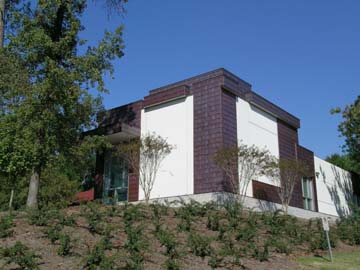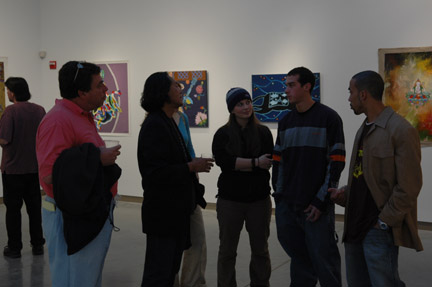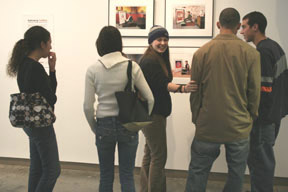Mechak's Third Exhibition Opens at Emory University
Leigh Miller

Visual Arts gallery, Emory University
Mechak's third exhibition and presentations by visiting artist Losang Gyatso, was held at Emory University in Atlanta, GA October 28 - December 3, 2005. Over 150 people attended the opening reception, and the subsequent weeks steadily drew more new audiences thanks to positive newspaper coverage, interdisciplinary sponsorship and promotion, and word of mouth. Audiences were stimulated, challenged and fascinated by this opportunity to explore contemporary Tibetan cultural imagery and issues.
The events were sponsored by the Emory Tibet Partnership along with the newly inaugurated Visual Arts Gallery of the Visual Arts Program at Emory, and the Asian Studies Program. Students and professors from various departments (studio arts, religion, Asian studies, and interdisciplinary studies) as well as members of the Buddhist and art communities of Atlanta were brought together by the surprising discovery of contemporary Tibetan art. Emory University has been fortunate to develop a wealth of resources for the study of traditional Tibetan Buddhist culture, from faculty in Buddhist philosophy, to funded research in the physiological and psychological benefits of meditation techniques, to monastic chanting performances and the construction of sand mandalas. The addition to campus of a visual arts gallery devoted to cutting edge, but as of yet widely unrecognized, art and artists provided an opportunity to highlight Tibetan culture as a culture which is also living and thriving in modern times.
were brought together by the surprising discovery of contemporary Tibetan art. Emory University has been fortunate to develop a wealth of resources for the study of traditional Tibetan Buddhist culture, from faculty in Buddhist philosophy, to funded research in the physiological and psychological benefits of meditation techniques, to monastic chanting performances and the construction of sand mandalas. The addition to campus of a visual arts gallery devoted to cutting edge, but as of yet widely unrecognized, art and artists provided an opportunity to highlight Tibetan culture as a culture which is also living and thriving in modern times.
The Exhibition: Rethinking Tradition: Three Contemporary Tibetan Artists in the West
The works of three Mechak artists were featured in Emory's Visual Arts Gallery exhibition: Losang Gyatso (USA), Gonkar Gyatso (England), and Karma Phuntsok (Australia). Atlantans were amazed to learn that contemporary Tibetan art exists at all. Moreover, they were impressed with the diverse ways in which these three artists used their unique visions to reflect a culture in dialogue with both its past and future. Beyond the astonishment the show sometimes generated in audiences witnessing the modernization of a culture typically associated with romantic representations of tradition, the artists each drew comments specific to their works. For example, one Tibetan student confronted his mixed reactions to Gongkar Gyatso's use of collaged glittering  pop culture stickers to form silhouettes of Buddhas (portfolio). On the one hand, he felt there was something inappropriate about the form of the Buddha rendered with such transient popular icons of materialism as Mickey Mouse and Pokèmon. On the other hand, he supposed innovations, even by those master thangka painters of the past, have always been met by hesitation from those accustomed to the status quo, and perhaps this is useful in a new age. For some American viewers, such works raised the question of the borders between Tibetan and postmodern western culture. When does the use of new techniques and materials become an imitation or assimilation into mainstream global culture, and when might it be adopted, according to indigenous aesthetics, for their own purposes? Gonkar's ability to fluidly juxtapose filling his Buddha-shaped spaces with delightful stickers, or with loaded quotations of Mao Zedong, attests to the complexity of Tibetan history and the artist's own struggles with identity politics.
pop culture stickers to form silhouettes of Buddhas (portfolio). On the one hand, he felt there was something inappropriate about the form of the Buddha rendered with such transient popular icons of materialism as Mickey Mouse and Pokèmon. On the other hand, he supposed innovations, even by those master thangka painters of the past, have always been met by hesitation from those accustomed to the status quo, and perhaps this is useful in a new age. For some American viewers, such works raised the question of the borders between Tibetan and postmodern western culture. When does the use of new techniques and materials become an imitation or assimilation into mainstream global culture, and when might it be adopted, according to indigenous aesthetics, for their own purposes? Gonkar's ability to fluidly juxtapose filling his Buddha-shaped spaces with delightful stickers, or with loaded quotations of Mao Zedong, attests to the complexity of Tibetan history and the artist's own struggles with identity politics.
The paintings included by Karma Phuntsok (portfolio) primarily featured recognizable Buddhist deities and ritual implements in novel placements within abstract, cosmic settings. Several of Karma's strikingly large works anchored the room, but their humble presentation without frames or stretchers invited viewers to inspect them closely. For many, the sense of spiritual depth common to traditional Tibetan Buddhist art was a palpable link to this present work, which suggested the continued pervasiveness of  enlightened beings in the universe. Keen observers were also intrigued by his cross cultural influences from Australia, particularly aboriginal art traditions visible in Karma's use of innumerable tiny golden dots covering the surface of several works. In addition to the blending of cultural heritages, he also mixes mastery of traditional thangka techniques for rendering highly detailed figures and objects, with contrasting playful exploration of expressionistic painting techniques in his ethereal backgrounds. Viewers familiar with Tibetan political history and thangka may have wondered whether the perfect but floating Buddhas, lacking the contextual references of the highly stylized environments of thangka, suggests the loss of familiar physical environment, but not core meanings, faced by Tibetans living in exile since 1959.
enlightened beings in the universe. Keen observers were also intrigued by his cross cultural influences from Australia, particularly aboriginal art traditions visible in Karma's use of innumerable tiny golden dots covering the surface of several works. In addition to the blending of cultural heritages, he also mixes mastery of traditional thangka techniques for rendering highly detailed figures and objects, with contrasting playful exploration of expressionistic painting techniques in his ethereal backgrounds. Viewers familiar with Tibetan political history and thangka may have wondered whether the perfect but floating Buddhas, lacking the contextual references of the highly stylized environments of thangka, suggests the loss of familiar physical environment, but not core meanings, faced by Tibetans living in exile since 1959.
Losang Gyatso's work (portfolio) most directly connected audiences with Tibet's long history of artistic material culture. From ancient petroglyphs to household items to ritual objects and dress, he captured imaginations with his fresh vivid strokes. Several viewers commented that knowing historical or religious background information was not a prerequisite for delighting in his paintings, but that when they heard the story of Virupa, or about Black Hat Dances or pre-Buddhist rock art, they were also impressed with the originality of his interpretation of these motifs. Graphic innovation led him to new forms and perspectives. Gyatso was present for the opening reception, and many attendees had the opportunity to speak with him. He told me that many of the people expressed their unexpected pleasure at seeing a whole new side of Tibetan culture that they found innovative, thought provoking and exciting.
Losang Gyatso's Visit
Losang Gyatso remained busy throughout his visit to Emory University with the installation of the show (which went through several interesting manifestations in collaboration with the Visual Arts Gallery faculty before being finalized), and meeting with faculty in religion, anthropology and visual arts, as well as classroom and public presentations. He was invited to speak to Geshe Lobsang Tenzin's class (The Culture of Buddhist Tibet), a colloquium for studio arts students, and at the Michael C. Carlos Museum. Equipped with images and humorous and provocative quotations about the life of artists and the purposes of art drawn from Tibetan and western art historical traditions, Gyatso charmed and educated his audiences.
For the intimate classes with college students, Gyatso spoke mainly on the linkages and departures with Tibetan visual tradition. For example, he said, there is a continuity in Tibetan art history and modern art practices in terms of its purpose - to convey some meaning which has relevance and importance broadly, beyond an individual artists' subjective or psychological expression. The system of thangka painting evolved to portray complex philosophical and cosmological concepts, yet they remained accessible and legible by all members of society. Likewise, Gyatso hopes his contemporary Tibetan art evokes a sense of Tibetan culture for viewers and not, as may be the mode of many western contemporary artists, merely an opaque individualistic expression of an artists' psyche. In fact, much symbolism in his work is drawn from Tibet's past - both Buddhist and pre-Buddhist - as a source of vitality and strength for the present. These works then become representational in the sense of a mental environment, as in thangka, and not representational of a specific ordinary physical human realm (thus also rejecting earlier periods of the western art historical tradition which valued realism). Gyatso expressed concern that as some contemporary Tibetan art becomes more pictorial, and also perhaps overly sentimental, it actually loses the essential cultural meanings which give it weight. Gyatso outlined a vision for the future of Tibetan art: it should continue to strive to maintain faithful expression and transmission of Tibetan values and worldview, within the changing external forms which suit the times. When expressing such views throughout his weeklong visit, listeners were struck by Gyatso's concluding confession. To be successful in this mission requires individual Tibetans, particularly those in exile where their communal numbers are limited, to carry a heavy burden to be a "condensed Tibetan", compressing an entire culture into their personal being.
As co-curator of the exhibition, I was asked to speak to some undergraduate classes in visual culture and Tibetan studies. The class Understanding Modern Tibet, taught by Dr. Tara Doyle, chose to meet at the gallery, where Gonkar Gyatso's My Identity  series became a focal point for discussions. Familiar with the histories of the Cultural Revolution, the exile government and settlements led by the Dalai Lama, and having met Tibetans in the West, students discovered they were able to 'read' the photographic series on a number of levels. In details such as the suitcase and tin roofs of No.3, evocative of early and poor days in Dharamsala, they appreciated a collective Tibetan experience. Meanwhile the tattoo of the artist, which reads 'Tibet' in Tibetan script, in the last photograph set in a generically modern studio, speaks to the individual struggles of the artist with personal identity throughout his multiple migrations. We also discussed the way in which the images' repetitive arrangement, focusing on the artist as a figure embedded in cultural settings, can inform us of the changing role of the artist in Tibetan society over the course of the twentieth century.
series became a focal point for discussions. Familiar with the histories of the Cultural Revolution, the exile government and settlements led by the Dalai Lama, and having met Tibetans in the West, students discovered they were able to 'read' the photographic series on a number of levels. In details such as the suitcase and tin roofs of No.3, evocative of early and poor days in Dharamsala, they appreciated a collective Tibetan experience. Meanwhile the tattoo of the artist, which reads 'Tibet' in Tibetan script, in the last photograph set in a generically modern studio, speaks to the individual struggles of the artist with personal identity throughout his multiple migrations. We also discussed the way in which the images' repetitive arrangement, focusing on the artist as a figure embedded in cultural settings, can inform us of the changing role of the artist in Tibetan society over the course of the twentieth century.
A public talk, A Conversation with Losang Gyatso, was hosted by the Michael C. Carlos Museum and facilitated by faculty members Dr. Tara Doyle (Religion) and Julia Kjelgaard (Visual Arts). Following my introduction to the exhibit and artists, Tara and Julia posed thoughtful but difficult questions which Gyatso responded to with eloquence and honesty. Tara's many years of experience with Tibetan exile communities in India led to provocative questions about cultural change and continuity in Tibetan communities at the present moment, as a second and third generation are born outside Tibet. Julia's career as an artist in many mediums, and two visits to Tibet, prompted questions about the artistic process and the relationships between creativity and location. The audience then posed a number of insightful questions, even referring explicitly to some of his paintings presented in the introductory slide show. Afterwards, a mixed group of faculty, artists, and friends enjoyed the evening, and the success of the Emory enterprise proved cause for rejoicing. The emergent movement of contemporary Tibetan art certainly merits additional research and exhibition.
All photographs by Jason Miller
